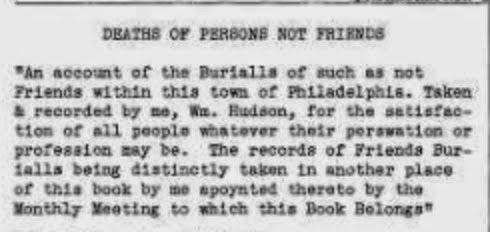My Moore research group believes that Rose Moore (our 9-gr-grandmother) was buried on this land. Probably James Moore (our 9-gr-grandfather) was buried here as well. William Penn gave his permission to use this land for burials in 1693. James Moore died in 1694. Rose did not die until after 1719 as her son, John Moore, mentions her in his will as his mother. In Hinshaw's Encyclopedia of Quaker Genealogy Vol II page 446 Roose Moore is mentioned in the section for the Philadelphia Monthly Meeting:
Roose Moore buried 6-27-1720. It does not specifically say that the list of these people were buried in the Quaker Graveyard, but it would seem to imply such a thing. James and Roose lived very close to the burying ground.
In 1701 William Penn officially donated the land at Arch Street to be used as a burial ground even though it was already in use as such. The burying ground was in use for 100 years until the 1793 Yellow Fever epidemic filled the entire grounds up. My guide, Jim Pettijo, said that people were dropping bodies over the walls of the burial ground in the middle of the night. That was the end of the use of this land as a burying ground.
The land was left unused until 1804 at which time the Quakers built the Arch Street Meeting house to be used as a Yearly Meeting. Jim also told me that meeting houses did not usually have walls nor fences around them. It is because it was first a burial ground that this Meeting House does have a wall.
Lynn sent me a URL for information about burials in the Philly area that he found on the Swarthmore site that I believe supports my gut feeling that both James and Rose are buried at Arch Street Meeting house: http://www.swarthmore.edu/library/friends/philaburials3.htm






No comments:
Post a Comment